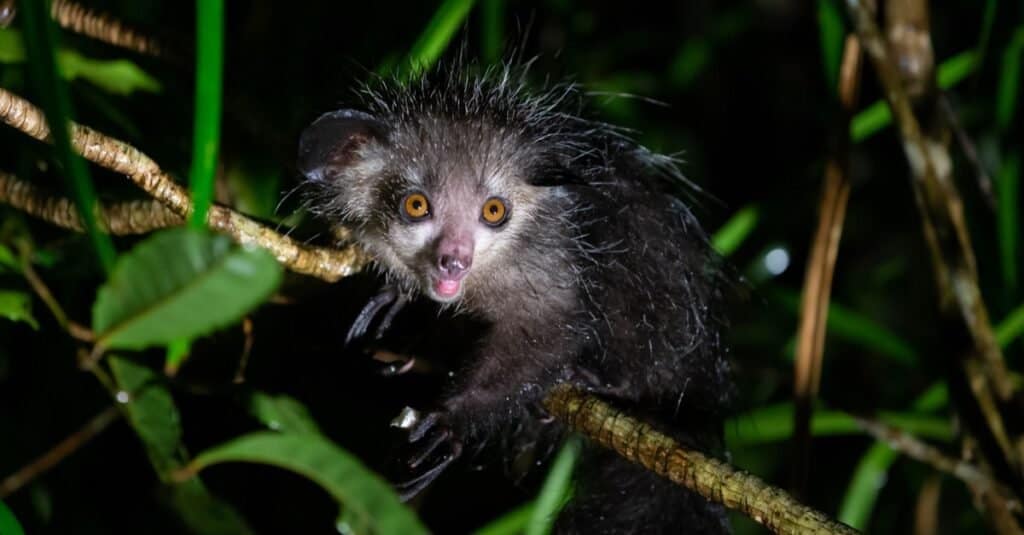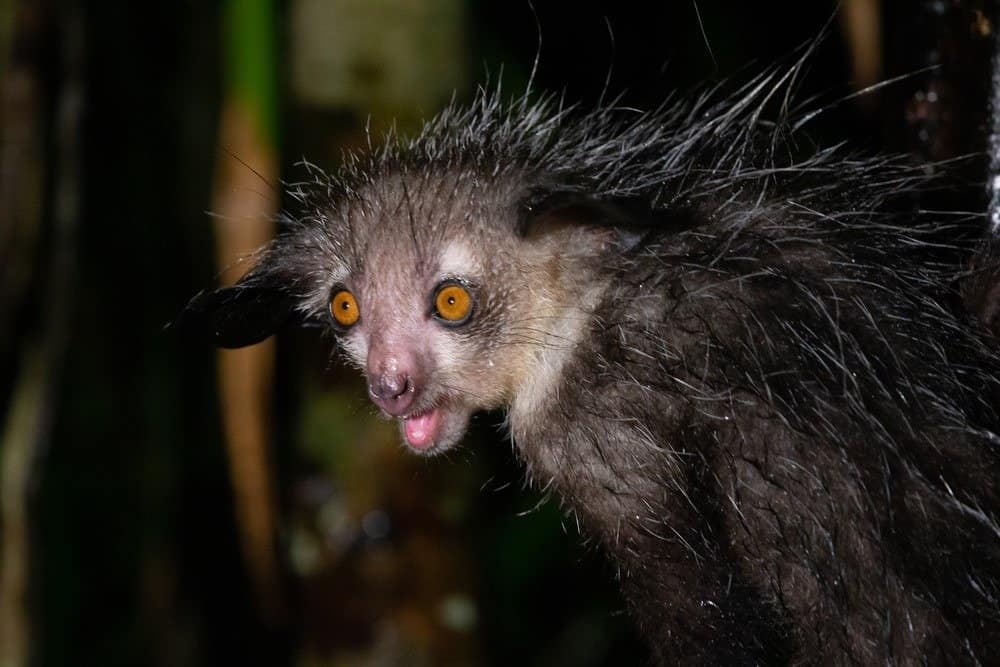Living deep in the heart of the Madagascan rainforest is a small but unusual animal that looks like a cross between a raccoon and a rat. Yet it is neither. Instead, it is an aye-aye. Aye-ayes are primates – lemurs to be exact – and are one of the most fascinating species in the world. Virtually everything about them is unusual – from their appearance to how they find their food. So join us as we discover 10 incredible aye aye facts!
1. Aye-ayes Have an Unusual Appearance
The most remarkable thing about aye-ayes is their appearance which is so unique and unusual that scientists have often debated over how to classify them. However, their unique appearance has a purpose as it means that they are specially adapted to help them forage for their food. Aye-ayes are around 2 feet long and have a bushy tail that is longer than their body. Their most distinctive feature is their fingers which are long and thin. Their third finger is thinner than the rest of them, but all have long, hooked nails. The purpose of their skinny fingers and sharp nails is to pull insects out of small holes in trees with them.
The other unusual feature of aye ayes is their teeth which are like those of a rodent. This means that they have incisor teeth that never stop growing. Aye-ayes are the only primates with teeth like this, which is why there has been difficulties in classifying them. They have these teeth so they can easily chew into tree trunks and branches in search of food without worrying about them getting worn down and becoming blunt.
2. Aye-ayes Spend most of their Lives in Trees
Aye-ayes live in the forests and rainforests of Madagascar, but you won’t see them on the floor. Instead, the place you need to look is high up in the canopy of the trees amongst the dense foliage. This is because aye-ayes are highly arboreal animals and spend most of their lives in the trees. Every aspect of their lives is carried out in the trees – eating, sleeping, mating, and traveling. Amazingly, they move around by leaping between the trees like a squirrel. They jump between the trees with ease and very rarely ever need to go down onto the ground while traveling. However, movement between trees is usually made by leaping vertically as horizontal jumps are more difficult for them.
3. They are the Largest Nocturnal Primate

Aye-ayes are the largest nocturnal primate.
©Eugen Haag/Shutterstock.com
Incredibly, aye-ayes are the largest nocturnal primate in the world. This might seem surprising since it would be easy to assume that this title would go to something like gorillas. Yet gorillas and baboons are both diurnal. In contrast, aye-ayes spend their night eating and traveling around the forest, while during the day they sleep in nests made from leaves and branches. They spend up to 80% of their night foraging for food and can travel up to 2.5 miles in one night alone.
4. Nests of Aye-ayes Look Like Balls in the Trees
As we’ve just mentioned, aye-ayes even sleep in the trees. However, their nests are particularly unusual as they look like round, closed-in balls in high up in the trees. These spherical nests are made from leaves and branches and are located in the forks of large, tall trees. They are so well built that they appear to be completely closed in with only a single hole for the entrance which is around 6 inches wide. Building the nest is a serious task and can take up to 24 hours to complete as they meticulously intertwine the branches to make it as sturdy as possible.
5. Aye-ayes use Echolocation
Echolocation is something that we better associate with bats, whales, and dolphins – and yet aye-ayes use it too. Aye-ayes are thought to be the only primate in the world to use echolocation and incredibly they use it to locate their prey. Aye-ayes are omnivores and eat a range of fruit, seeds, nectar, insects, insect larvae, and honey. They use echolocation to find grubs and insects in the hollow cavities of trees. Incredibly, aye-ayes actually fill in the same spot in the ecosystem as a woodpecker with the way they chew into the trees.
Aye-ayes use echolocation by tapping on the tree with their long middle finger. They then listen for the echoes to help them locate the insects in the hollow chambers within the wood. They tap on the tree up to eight times per second and are known as “percussion foragers”. Aye-ayes then chew a hole in the tree and use the same long finger to fish their food out with. By using echolocation to determine the exact location of the insects within the tree they can accurately choose their spot to make a hole, rather than having to just guess.
6. Baby Aye-ayes Stay with Their Mother for Two Years
Aye-ayes actually have a fairly slow reproductive rate. They only mate every 2 to 3 years and in part this is because their young stay with them for 2 years. Aye-ayes give birth to one baby after a gestation period of approximately six months. Baby aye-ayes are tiny when they are born and only weigh between 0.2 and 0.3 pounds. They rely heavily on their mother for the first weeks and months of their lives. However, they are weaned from their mother’s milk by the time they are 7 months to a year old. Despite this, they still remain with their mother until they are around 2 years old. This is so that they can learn everything that they need to know about survival from her. Female aye-ayes reach sexual maturity when they are 2.5 years old and males a little younger.
7. Aye-ayes sometimes Hang Upside Down

Aye ayes sometimes hang upside down in trees to rest.
©Eugen Haag/Shutterstock.com
Sometimes when aye ayes have been busy foraging, they need a little rest, and what better way to relax than to hang upside down from a tree branch! That’s right, aye ayes sometimes just hang upside down for a rest as they’re able to sleep vertically and horizontally. They also sometimes hang from tree branches while mating – which can last for more than 2 hours!
8. Each Aye-aye has their Own Range
Aye-ayes are extremely solitary animals. They rarely interact with others except for when they are mating and mothers with their young. As they are solitary, each aye-aye has their own individual home range, although sometimes they can overlap with others. Aye-ayes mark their territory by using their urine and their scent glands. They have scent glands on their rumps, cheeks, and neck. Female aye-ayes tend to have smaller ranges than males. They often overlap with the territories of one or two males, which is useful for when they are mating. Although they live solitary lives, aye-ayes still manage to communicate using a wide range of vocalizations such as screams and whimpers. Their large, triangular-shaped ears are highly sensitive and help them to pick up sounds of other aye-ayes even from miles away.
9. According to Folklore Aye-ayes are Evil

In Malaysia, the aye-aye is considered to be bad luck.
©iStock.com/javarman3
Aye-ayes have a really bad reputation thanks to folklore which claims that they are evil. Some tales claim that if the aye-aye points its thinnest finger at someone, it consigns that person to death. As many people believe that they are harbingers of doom, they are often killed on sight.
10. Aye-ayes were Once Thought To be Extinct
Although aye-ayes are officially an endangered species they were once thought to be extinct! They were thought to go extinct in 1933, and for 24 years, they were thought to be lost entirely. Amazingly, they were rediscovered in 1957, though. However, as they are endangered, they are at serious risk, and the greatest threat to their population comes from us humans. As we’ve just mentioned, aye-ayes are often killed on sight due to superstition, but they are also killed by poachers and farmers who think they destroy their crops. Aye-ayes are also threatened through habitat loss due to deforestation. There also used to be a giant aye-aye, but this species became extinct at some point within the last 1,000 years and is only known from fossils.
The photo featured at the top of this post is © javarman/Shutterstock.com
Thank you for reading! Have some feedback for us? Contact the AZ Animals editorial team.






